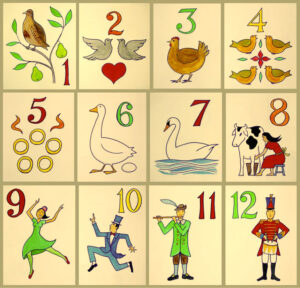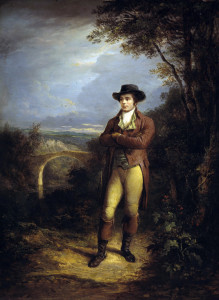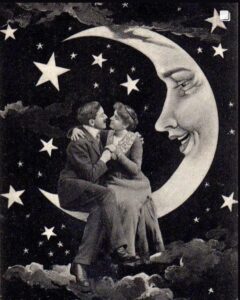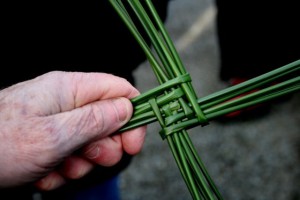
It’s Christmas. The nights are long and cold (even here in Lake Worth this year) but our hearts are open and love calls us to the things of this world that we most cherish. December for us –– like most all of 2022 –– was a mad dash and, to be honest, a bit of a blur. Seth and I marked the passing days of Advent as best we could but here we are late on Christmas Night and though our tree is not yet decorated (I think that’s coming tomorrow), all is right with the world. Our Christmas Eve and Christmas Day were just as they should be, and now, we enter into the Twelve Days of Christmas and we say, “Welcome Yule.”
There are two approaches to the calculation of these Twelve Days: One approach has the Twelve Days of Christmas beginning on Christmas Day itself, while the other starts them on St. Stephen’s Day, the 26th of December. In this house, we subscribe to the second approach. Our ancestors, who perhaps were more attuned than we to the passing of the days and to each day’s meaning, loved symmetry in numbers, and the second approach provides exactly that. Christmas Day itself has long been seen as a day outside ordinary time. For those of us who follow the model of St. Stephen’s Day being the First Day of Christmas, Christmas Day is seen as a distinct day, followed by a beautiful symmetry that comes along with the passing of the year. In this model, we have six days of Christmas in the old year and six days in the new, creating a balanced bridge at the start and end of each year, a balance that links the other old story –– that of the ever expanding round of the year as this old earth spins on its axis and rotates around the sun –– to the story of the child’s birth at Bethlehem. The links connect Christmas through the years in a lovely balance. More mystery, of the universal sort, heavenly yet here on earth.
However you count your days, I am here simply to encourage you to mark them. I hope you’ll join us at your home in celebrating the full season that lasts through Epiphany on the Sixth of January. And if you are a bit in love with Christmas as we are in this household, welcome. Advent has ended, Christmas has made itself welcome, and its season has just begun. Our Christmas tree and other greenery will be illuminated tonight and every night through Epiphany, and most likely we will go even beyond, for traditionally the greenery would come down at Candlemas Eve: the First of February. Keeping it up longer would invite goblins into your home, and no one wants that. But to bring light and cheer through all the dark month of January is, I think, a wonderful thing.
Here then, is my Convivio Quick Guide to the Twelve Days. A few farm stand and pantry items are handy to stock up on for this season. My recommendations: apples, chestnuts, mulling spices, honey, red wine, fresh cider, and rose water. We can supply your mulling spices and rose water; ours are both made by the Sabbathday Lake Shakers and we’ll ship via US Priority Mail to get your domestic order to you in just two or three days.
So, here we go: Christmas Day, December 25, is a day outside ordinary time. It stands alone in its holiness, a holyday/holiday if ever there was one. December 26 brings the First Day of Christmas: it is St. Stephen’s Day, and Boxing Day. It was my grandmother’s tradition to make soup for St. Stephen’s Day, which is a custom she brought from her Italian homeland, and we follow her custom, too. This zuppa –– soup in Italian –– provides a pause for lighter fare after the rich feasts of Christmas Eve and Christmas Day. I will make for St. Stephen’s Day a typical chicken soup, but instead of adding orzo or pastina just before serving, I’ll add tortellini, which is perhaps a bit more festive and a bit more fitting to the Christmas season. The 26th also brings the start of a newer tradition, the First Day of Kwanzaa, which brings yet more light to the world through candles: each candle and each day, through the First of January, focusing on one of seven principles: first, umoja (unity); then kujichagulia (self-determination); next, ujima (collective work and responsibility); followed by ujamaa (cooperative economics); and then nia (purpose); kuumba (creativity); and finally imani (faith).
The Second Day of Christmas, December 27, is St. John’s Day, and it is typically celebrated with wine. St. John the Evangelist was the only one of Christ’s disciples who did not meet a violent end for his beliefs. Several attempts were made on his life, though, the most famous of which involved poisoned wine, which had no effect on the man. And so his day is a good one for one of the loveliest drinks of the Yuletide season, mulled wine. Here’s our recipe:
M U L L E D W I N E
A bottle of good red wine
Mulling spices (a blend of cinnamon, cloves, allspice, orange peel)
Sugar
Pour a quantity (enough for as many people as you are serving) of good red wine into a stainless steel pot and set it on the stove over medium heat. Add about a teaspoon of mulling spices for each serving. Add sugar: start with a teaspoon or two of sugar and add more to taste. We prefer a less-sweet mulled wine, and while you can always add more sugar, you can’t take it away once it’s in. So my recommendation is to add the sugar gradually, tasting as you go. Heat to allow the spicy flavors to infuse the wine, but do not allow to boil. Strain before serving in cups (not glasses).
The Third Day of Christmas on December 28 brings Childremas, or Holy Innocents’ Day. It marks a dark day in history but I prefer to mark it with celebrating children and the children we once were. Play with kids, read children’s books. In Spain and Latin America, it’s a day for practical jokes. December 29 brings the Fourth Day of Christmas and the Feast of Fools, so make it as goofy a day as you’d like. My favorite thing to do this day? Watch Christmas at Pee-Wee’s Playhouse: it’s brilliant! There are no particular traditions associated with the Fifth Day of Christmas on December 30, but we have long reserved it as one for honoring the old Boar’s Head Carol and for feasting (feasting being a common theme for all the Twelve Days)… and whatever we serve this night, whether it be something elaborate or something simple, we do it with great fanfare, just as is done in the Boar’s Head Carol, which begins thusly: The boar’s head in hand bear I, bedecked with bays and rosemary, and I pray you my masters be merry, quot estis in convivio! The Boar’s Head Carol is our Convivio Bookworks namesake, so this is a special day for us here in this house.
December 31 is of course New Year’s Eve and this is the focus for the Sixth Day of Christmas, as we say farewell to the old year and usher in the new. The Seventh Day of Christmas brings New Year’s Day, and it is traditional to sing and toast the apple trees. The act is called wassailing and the drink is wassail, as well. Get outside, honor your favorite tree, apple or not, give it a toast. Here’s our Wassail recipe:
C O N V I V I O W A S S A I L
Pour the contents of two large bottles of beer or ale (about 4 pints) into a pot and place it on the stove to heat slowly. Add about a half cup sugar and a healthy dose of mulling spices. (If you don’t have mulling spices on hand, you can use cinnamon sticks and whole cloves… though the mulling spices lend a more complex flavor.) Add a half pint each of orange juice and pineapple juice, as well as the juice of a large lemon. Peel and slice two apples and place the apple slices into the pot, too. Heat the brew but don’t let it boil, then pour the heated wassail into a punchbowl to serve.
The Second of January brings the Eighth Day of Christmas, which is St. Macarius’s Day. Macarius was a dour old chap but in his younger days he operated a confectionary in Alexandria. Between that and the fact that his name is so close to two different delicious confections, it is a day some call St. Macaroon’s Day. It is known as a day to enjoy sweets. We celebrate St. Genevieve on the Third of January, the Ninth Day of Christmas. She is a patron saint of Paris, founder there in 475 of Saint-Denys de la Chapelle, which stands today as part of the Basilica of St. Denis. Another of the saints we celebrate this dark time of year that is associated with light, Genevieve’s was a light that never went out. It is said that even as the devil would attempt to interrupt her prayers by blowing out her candle, Genevieve had the power to relight it without use of flint nor fire. She just willed it to happen. Talk about a light bearer. This Ninth Day is one to celebrate with candles and is a very good day for Francophiles to be in their element. Perhaps your evening meal should be French. The Tenth Day of Christmas on January 4 has little going on, traditionally speaking. I think of it as a good day for reflection, and for preparation for Twelfth Night, which comes on the evening of January 5, the Eleventh Day of Christmas. This is traditionally a cracking good party, a proper send off for Yule and old Father Christmas. In the overnight hours, la Befana, one of the last of the midwinter gift bearers, will make her way through Italy on a broom bringing small presents to good children and delicious sweet coal to naughty ones––so it’s hard to choose which is better. We Italians like to keep things ambiguous. In Spain and Latin America, los Tres Reyes will be delivering presents. The stories of la Befana and los Tres Reyes are intertwined… the three kings stopped at la Befana’s on their way to visit the Christ child and invited her along, but she, like most Italian women I know, had far too much to do, so she declined their invitation, and then later had misgivings about that decision. Still to this day she searches for the child each Epiphany Eve.
January 6 brings Epiphany and the Twelfth Day of Christmas. This is traditionally seen as the day the Magi arrived at the stable to see the child and to bring gifts of frankincense, gold, and myrrh. Our tradition in this house is one we witnessed remnants of far and wide on our travels a few years back in Austria, Switzerland, and Germany: We gather together outside our front door, and all who are gathered take turns writing the elements of an inscription in chalk on the lintel above the door. The inscription is comprised of the initials of the Magi (C for Caspar, M for Melchior, B for Balthasar), blanketed on each side by the year, punctuated with crosses: this time around then, it will be 20+C+M+B+23. Each year, my silent prayer outside in the cold night air is that no one will be missing when we next gather to do this. With this, we find ourselves on the other side of the balanced bridge that brought us from one year to the next through the portal of Christmas.
For Epiphany, we typically make Three Kings Cakes: the recipe yields three cakes, cakes you will prepare in three loaf pans. You will end up with one cake for each of the Magi, who have traditionally been called Caspar, Melchior, and Balthasar, though no one knows who they were really. As the story goes, it took the Magi all these twelve days to travel through the desert, and seeing the child lying in the straw was their great epiphany.
T H R E E K I N G S C A K E S
makes three cakes
For the Batter
1 cup butter
generous 3/4 cup sugar
2 eggs
2 teaspoons vanilla
2 1/2 cups currants
3 cups applesauce
1/2 teaspoon salt
1 tablespoon baking soda
1 teaspoon cinnamon
1/2 teaspoon ground cloves
4 cups flour
Preheat oven to 300 degrees. Cream together the butter and the sugar, then add the eggs and vanilla. Beat smooth before adding the remaining ingredients. Grease 3 loaf pans (about 8″ x 4″ x 3″ or so) and divide the batter amongst the pans. Bake for one hour, or until a toothpick poked into the center of each cake comes out dry. Let the cakes cool in their pans on a rack.
For the Syrup
1/2 cup honey
1/2 cup sugar
1/2 cup water
1 cinnamon stick
6 whole cloves
2 tablespoons rose water
Once the cakes are baked, combine the syrup ingredients, except for the rose water, in a saucepan over medium heat. Once the sugar dissolves, add the rose water. Remove the cinnamon stick and the cloves and then pour the hot syrup over the cakes in their pans, divided equally amongst the three cakes. The syrup will soak into the cakes. Allow to cool completely before unmolding from the pans. Serving the three cakes on three platters makes for a nice presentation on Epiphany Day or on Twelfth Night.
With Epiphany’s close, most people will remove the greenery from their home, although we, as I mentioned earlier, follow the older tradition of keeping the yuletide greenery in the house until Candlemas at the start of February. Whenever you do take your tree out of your home, here’s a tradition of our own making that we invite you to participate in: we save our tree, in a corner of our yard, to use for a midwinter solstice fire the following December (or anytime through the Christmas season). It’s another way of bridging one yuletide season to the next, of maintaining that connexion of one year to another.
May these Twelve Days bring only joy your way. Seth and I, we bid you this, and we bid you peace. Merry Christmas.
Image: Twelve Days of Christmas. Unknown artist, courtesy Wikimedia Commons.





